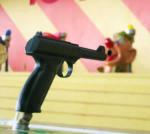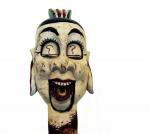What’s your story?
Share and find customer experiences
Connect with the people behind them
Wacktrap is
feedback made social
Trending Content
FBI Credible Lead DB Cooper Suspect Print May Confirm Ransom Man Dead
by hearit
He's the guy that jumped out of a plane 40 years ago with a pile of cash. The FBI is on a roll: After capturing Whitey Bulger, the agency's got a 'credible lead' for another of its 'Most Wanted'. There's a suspect in the D.B. Cooper search--and possibly a fingerprint--that may confirm the parachuting ransom man dead.
If the FBI's right about its suspect, it may all mean the man who gave the name 'Dan Cooper' on board a hijacked plane didn't expire how FBI agents previously may have thought.
Straight out of Washington D.C., a federal law enforcement official confirms the FBI is in fact investigating what's being called a 'credible lead' on the infamous D.B. Cooper who escaped a flying plane with loads of cash. For Cooper, that may have been his last flight and final getaway: The FBI is debating whether the remains of a dead man now found in the Pacific Northwest may well be those of D.B. Cooper. D.B. Cooper is best known for hijacking a passenger jet in 1971 -- roughly 40 years ago -- and parachuting from that plane with one-fifth of a million bucks ($200,000 dollars) in ransom money.
A man who provided the name of 'Dan Cooper' and carrying only a black briefcase or attache had bought a one-way ticket in the U.S. to Seattle, Washington, the day prior to Thanksgiving in 1971. It was slated to be short flight of just 30 minutes. That airplane ticket had been purchased at the Portland airport for a flight via Northwest Orient Airlines, Flight Number 305. Described as being in his mid-40s, with a wide range of heights that varied by four inches -- between 5' 10" and 6' 2" -- Cooper was dressed in a black raincoat, dark suit, white shirt and matching black tie. 'Dan Cooper' was also wearing a mother-of-pearl tie pin, which may now serve as the link being used in a match-up for fingerprinting related to possessions of the deceased man the FBI is investigating.
Cooper is said to have ordered a bourbon and water and lit a cigarette before casually calling over a stewardess and -- similarly to a bank robbery -- handing the flight attendant a note printed in all caps which read: "I have a bomb in my briefcase. I will use it [the bomb] if necessary. I want you to sit next to me. You are being hijacked."
After landing in Seattle late afternoon where the plane was refueled, the ransom and parachutes had been delivered by early evening -- the airplane carrying D.B. Cooper taking off for Reno, Nevada. and the plane took off for Reno. At 8:13 p.m, the jet's tail experienced a sudden upward movement. When the jet landed in Nevada, the mysterious Cooper was no longer on board. And he's been missing since, for four decades.
Since 'Dan' was last seen in a 'farewell' of sorts in 1971, the guy by the name of D.B. Cooper has never been found despite remaining on the FBI's list of most wanted. His recent lack of turning up may be for good reason -- like being deceased. The Federal Bureau of Investigation has checked out at least 1,000 leads over the past forty years since its suspect bailed out of a plane on Nov. 24, 1971, while the jet was cruising over the Pacific Northwest. The FBI is now investigating a lead it claims credible, and which the agency dubs "interesting" -- the idea being whether it's likely the ransom man has been dead, based on a tip the agency got a few months ago from a law enforcement source. It seems a tipster requested anonymity. But the FBI follow-up has meant personal effects have reportedly been requested from the possible suspect's location. That suspect is a man who died years ago of natural causes.
The FBI isn't releasing specifics, yet, as to exactly how many years ago that death may have been, but estimates are placing the deceased at about a decade ago. The new tip now makes it plausible the infamous flight was not Cooper's final 'hurrah' as the FBI had previously speculated. Agents previously, reportedly, thought D.B. Cooper may have died during his jump from the plane. The D.B. Cooper story of a man on the run has been featured in roughly a dozen books and a movie.
There's good reason those 'personal effects' could be so crucial for the FBI. Reportedly at least one item belonging to the suspect had been forwarded to a Virginia lab for forensics testing. Many years ago, law enforcement may have been able to capture at least a partial finger print left on either a magazine or tie clip left behind in the plane from which D.B. Cooper catapulted -- the ransom man escaping from law enforcement by using a parachute to jump from the hijacked airplane. So it comes down to the obvious: If the FBI can match up fingerprints, the agency just might have its man. The FBI is trying to find fingerprints or some DNA on personal effectsof the deceased -- to compare with at least one item left behind by the infamous hijacker.
So who is the mystery man, D.B. Cooper? That would be a good question. And the FBI would like to know. No one knows the true name of the man who went by 'Dan' as far as the airline was concerned. Cooper has successfully evaded authorities and become known for one of the 'greatest' escapes to date. In fact the Cooper case remains the single only remaining airline hijacking in American aviation history that has never been solved. Cops claim the man known as 'Dan' put a lot of lives of risk, but it seems he did so congenially -- and it still remains a mystery as to how Cooper successfully jumped with a parachute and money, at night in dark skies.
How did 'Dan Cooper' become D.B. Cooper? That part's equally strange. The man who gave the alias of 'Dan' had a bit of a media mix-up: Reporters accidentally began referring to 'Dan Cooper' as 'D.B.' -- and the name kind of stuck.
Airline passengers today can partially thank D.B. Cooper for increased screening and security. Far before 9-11, the man singlehandedly caused a huge shift in air travel screening procedures. It wasn't until D.B. Cooper's skydive that passengers were no longer able to physically carry a bomb on board a jet without a second glance. That may not have been the worst thing, as hijackers continued to invade airplanes during the 1970s -- and continued to 'up' the violence factor.
To the contrary of the physical violence that became so common, D.B. Cooper harmed no one in his air escapade -- with the exception of the $200,000 he stole in ransom -- and was virtually a celebrity figure in the '70s. Copycats tried to follow the act of D.B. Cooper, the man who is ironically thought to have been a copycat himself: the parachuter is thought to have copied a hijacking that occurred just weeks before his nighttime jump.
The stewardess who received Cooper's note, Florence Schaffner, discreetly and quietly asked to see evidence of the bomb and reportedly 'Dan' cracked the briefcase open for her to view eight red cylinders that appeared to be attached to red wires and a large battery. D.B. Cooper then reportedly told the Northwest Orient Airlines stewardess: "I want $200,000 in unmarked 20-dollar bills. I want two back parachutes and two front parachutes. When we land, I want a fuel truck ready to refuel. No funny stuff or I’ll do the job." -- and told Schaffner to give the cockpit and pilot his instructions. Plane passengers were simply told their arrival to Seattle was slated for delay due to "minor mechanical difficulty."
It took the FBI a bit of maneuvering: The four parachutes had to be ordered from a skydiving school in the area.
Where the ransom money came from is rarely discussed in the story of D.B. Cooper. Those ransom funds to Cooper were actually authorized and provided by the hijacked airline. Donald Nyrop, Northwest Orient's president, authorized the $200,000 dollars in ransom money to be paid to Cooper -- and additionally told Northwest airline employees to fully cooperate with the hijacker. But the airline had to keep itself busy while organizing how to get D.B. Cooper the ransom money requested. On-board passengers of Flight 305 got to see a lot of what must've looked like similar terrain: The Northwest Orient jet circled Puget Sound for almost two hours so that Seattle police and the FBI could deliver the ransom to the unknown man.
The Northwest Orient flight attendant described D.B. Cooper as nice. Apparently he was a thoughtful thief -- ensuring the stewardesses got fed during the whole scene, and paid and tipped for his drinks.
FBI agents tried to ensure traceable bills and funds given D.B. Cooper. The ransom money came from Seattle-area banks and was provided as 10,000 unmarked $20-dollar bills. The bulk of twenties contained serial numbers beginning with the letter "L" -- issued by the Federal Reserve Bank of San Francisco, most with a "Series 1969-C" designation. Somehow the FBI was able to make a microfilm photo of each bill. D.B. Cooper refused the military-issue parachutes the FBI tried to offer -- instead demanding civilian parachutes with manual rip cords, which sent Seattle police scurrying to a local skydiving school.
After a re-fueling in Seattle, where all the plane's passengers and crew were released, the Northwest Orient plane took off again. It's a mystery, since no one actually saw D.B. Cooper jump from the plane. After takeoff, Cooper instructed crew to remain in the cockpit behind a closed door. A stewardess named Mucklow saw Cooper tie something around his waist and, shortly after 8:00 p.m., a warning light in the cockpit told crew members that the jet's airstair had been activated -- a staircase lowered. The Northwest Orient crew reports a change in air pressure and that its offer to assist Cooper over intercom was refused. When the plane landed at 10:15 p.m., D.B. Cooper and the cash was vanished.
But 66 unidentified fingerprints remained. Also on-board the hijacked plane: D.B. Cooper's black clip-on tie and a mother of pearl tie clip -- along with two of the four parachutes, one of the remaining parachutes opened and two shroud lines cut from its canopy. Cooper had requested the plane not exceed 10,000 feet. The FBI expressed doubt the man had survived the nighttime jump, but decades never revealed his body -- in an aviation mystery never resolved. In the Spring of 1972, teams of FBI agents and roughly 200 Army soldiers, Air Force personnel, National Guard troops and even civilians searched Clark and Cowlitz Counties for eighteen days in March. Another eighteen days of a search followed in April. Despite more than a month of searching, no trace of D.B. Cooper was found. Even a marine salvage firm that searched a 200-foot deep Lake Merwin by submarine found no clue. The search for Dan Cooper -- which became the most extensive and intensive in United States history, uncovered nothing related to the incredible hijacking and escape.
Had D.B. Cooper been caught -- or should he ever be captured -- alive, the hijacker might still have legally escaped. A statue of limitations, for prosecuting the hijacker and ransom man, would have expired in 1976. To preserve the right to prosecute, a Portland grand jury returned an indictment against "John Doe, a.k.a. Dan Cooper" for air piracy and violating the Hobbs Act. That indictment against Cooper meant he could still be prosecuted at any time the hijacker might be captured in the future. That indictment is now more than three decades old, and there hasn't been a sign of Cooper since, though some of the ransom money did show up.
Seven years after Cooper jumped from the hijacked Northwest plane, a placard containing instructions for lowering the aft stairs of a Boeing 727 was found by a deer hunter in 1978. The placard did indeed come from the hijacked jet -- the instructions found within the plane's flight path near Castle Rock, Washington. Then some cash showed up.
Apparently the boy who found it was a 'Good Samaritan', turning in a wad of cash to law enforcement, money he found while building a campfire in 1980. An eight-year-old boy named Brian Ingram was by the Columbia River near Vancouver, Washington, with family when he discovered three packs of D.B. Cooper's ransom cash -- disintegrating and with rounded edges, but bundled in rubber bands when found on a riverbank. Verified as part of the ransom money provided to Cooper by the FBI, the cash included two packets of 100 $20-dollar bills each and a third packet containing 90 of the twenties -- less than three grand of the $200,000.
In 2007, the FBI announced it had a partial DNA profile for D.B. Cooper based on the tie clip left on board. The agency also announced some interesting facts or claims about the parachutes provided to Cooper: One of the two reserve parachutes the FBI provided -- from the Seattle skydiving school -- was reportedly a "dummy" and unusable. Perhaps the agency was betting on a lack of parachuting skills. Despite markings of a dummy parachute, the FBI says D.B. Cooper chose that parachute for his jump. The usable, reserve, parachute had been torn by Cooper -- the FBI believes it was torn to tie the bag of money closed for his jump. The FBI also says Cooper chose the older of the two main parachutes, bypassing a technically superior professional parachute. The gist: D.B. Cooper may not have really known what his doing.
But despite all those factors, and against all odds, it appears D.B. Cooper may have made it. And may be yet another 'Most Wanted' criminal to come off the FBI's list in 2011.
Location
SPEED UP YOUR ONLINE GROWTH
How To Wack
Take the Tour
Click on any image to start











